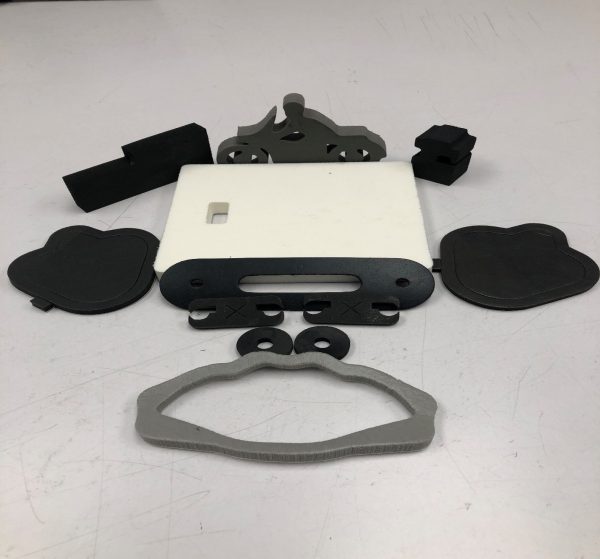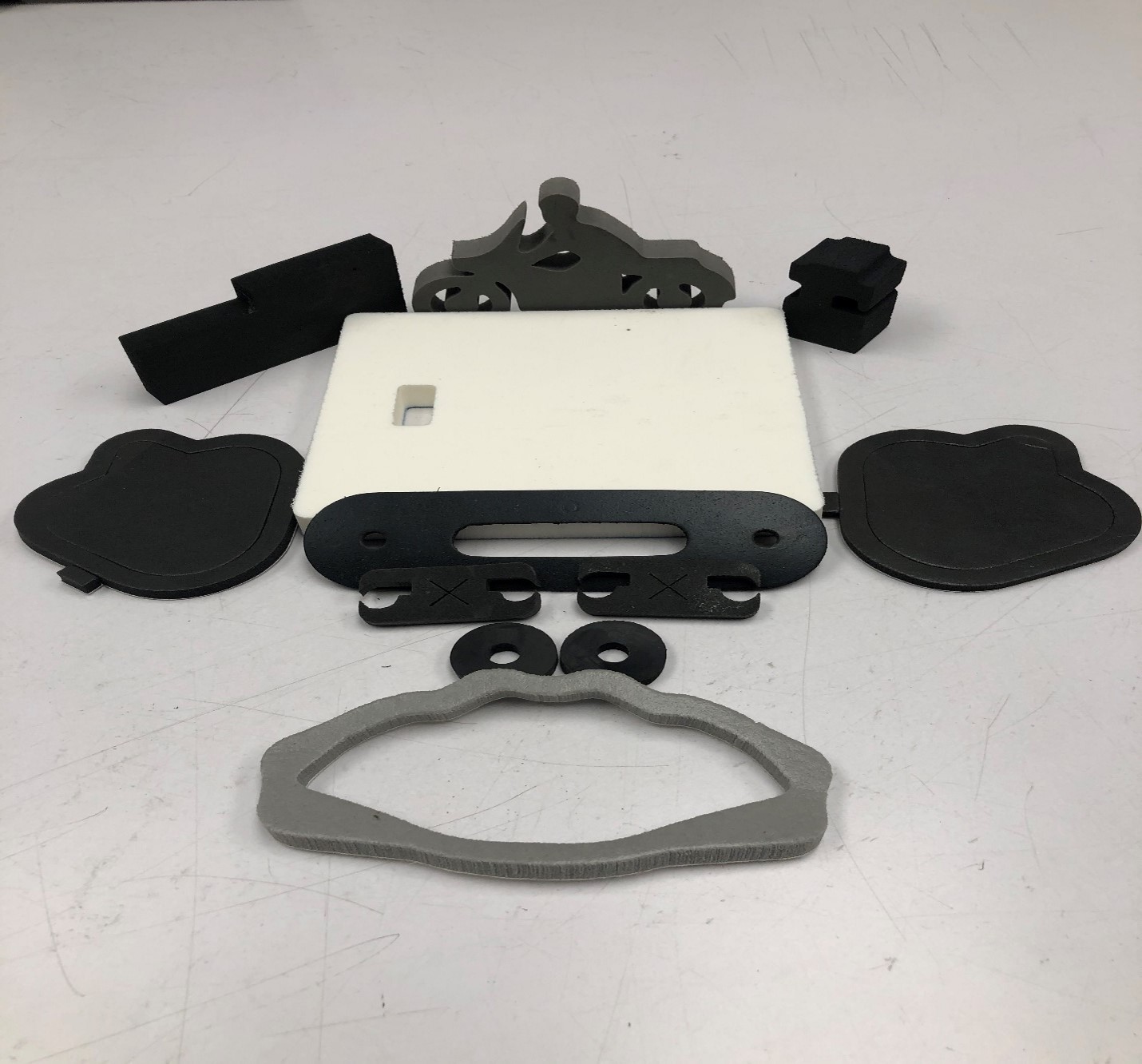
I’ve always liked the term “workhorse”. Some might think that anything called workhorse is common, unremarkable, or just boring. I’ve always thought workhorse is a compliment. It means strong, reliable, and able to work day in and day out without drawing a lot of attention to itself.
When considering gasket materials, the workhorse analogy is very useful. There are a handful of gasket materials that do an excellent job for 75-80% of gasketing and sealing applications. The “thoroughbred” gasketing materials such as silicones and fluroelastomers are highly specialized. They have broader performance properties especially for low and high temperature exposure but come with a much higher price tag.
Background on Gasket Materials
The materials outlined in this post will typically have an operating temperature range of -40° to 250°F (-40° to 121°C). Some of them such as cross-linked polyethylene (XLPE) will only handle an upper temperature limit of about 200°F (93°C). Some of them are available as solid rubber and also in foam or sponge format (foam and sponge are often used interchangeably but there are some differences). Some are only available as a foam. In the case of foam or sponge, there can sometimes be open cell versions or closed cell versions.
PVC (Polyvinyl Chloride)
Closed cell PVC is available in a variety of densities and exhibits excellent UV resistance, cushioning, and sound damping properties. It is used in many gasketing and sealing applications with a service temperature range of -40°F to 200°F. The
Norseal® brand of PVC foams from Saint Gobain are available in gray and black with or without adhesive for easy installation.
Polyurethane (PU or just urethane)
Polyurethanes are available in both foam and solid forms. Solid polyurethane is extremely abrasion resistant and typically used in very special applications. The foam version, also called microcellular urethane foam, is more common. The very fine cell structure gives this foam excellent compression set resistance so it will not collapse and can be resealed many times. These foams also offer excellent shock dissipation along with moisture and chemical resistance and are available in several densities.
EPDM (Ethylene Propylene Diene Monomer)
EPDM is a synthetic elastomer that is available in both solid and sponge form. The diene monomer permits this rubber to cross-link giving EPDM it’s excellent UV and aging characteristics; especially outdoors. EPDM performs well in temperatures from -60° to 250°F but its’ Achille’s heel is poor resistance to hydrocarbons such as oil, gasoline, and kerosene.
Neoprene (Polychloroprene)
Neoprene is also a workhorse synthetic elastomer available in both solid and sponge form in soft, medium, and firm densities. It is the antithesis to EPDM in two ways; it has great resistance to oils, gasoline, grease, and kerosene but does not exhibit the UV and aging stability that EPDM possesses. It has the same 250°F upper end service temperature as EPDM.
Nitrile Rubber (Nitrile Butadiene Rubber – NBR, Buna-N, Acrylonitrile Butadiene – ACN)
Nitrile rubber is also a synthetic elastomer with very good resilience. Properties can be adjusted by varying the acrylonitrile to butadiene ratios. The lower the acrylonitrile content, the lower the Tg and the higher the ratio the better resistance it will have to gasoline, oils, and many other chemicals. It has excellent tensile strength and is resistant to petrochemicals. This makes it the ideal choice for O-rings and other automotive and aerospace gasket applications. Nitrile rubber has a service temperature range of -40°to 225°F.
Cross-Linked Polyethylene (XLPE)
Cross-linked polyethylene foam undergoes a cross-linking step via irradiation or chemical cross-linking to yield a closed cell foam with higher tensile strength and compression set resistance than common polyethylene foams. It is an ideal gasket material where the upper temperature limit will not exceed 180°F.
Blended Foams
As the name implies, blended foams seek to capitalize on the strengths of some elastomers and limit weaknesses by blending them. Two workhorse foams from
Rubberlite are their SCE41B (a blend of neoprene, EPDM, and styrene butadiene rubber) and their VNN IV1 (a blend of PVC, nitrile rubber, and chlorinated rubber. Both of these blended foams have a service temperature range of -40° to 200°F. and excellent physical properties for gasketing applications.
Summary of Gasket Materials
The term “workhorse” does not necessarily mean unremarkable or boring. It can signify strength and reliability. There are seven classes of workhorse foams that can handle 75-80% of gasketing and sealing applications. These gasket materials can be provided as die cut parts, slit rolls, or laminated to other materials. TBI has the materials science and process expertise to help you with your project. Contact us today at
www.tbi.com.
 I’ve always liked the term “workhorse”. Some might think that anything called workhorse is common, unremarkable, or just boring. I’ve always thought workhorse is a compliment. It means strong, reliable, and able to work day in and day out without drawing a lot of attention to itself.
When considering gasket materials, the workhorse analogy is very useful. There are a handful of gasket materials that do an excellent job for 75-80% of gasketing and sealing applications. The “thoroughbred” gasketing materials such as silicones and fluroelastomers are highly specialized. They have broader performance properties especially for low and high temperature exposure but come with a much higher price tag.
I’ve always liked the term “workhorse”. Some might think that anything called workhorse is common, unremarkable, or just boring. I’ve always thought workhorse is a compliment. It means strong, reliable, and able to work day in and day out without drawing a lot of attention to itself.
When considering gasket materials, the workhorse analogy is very useful. There are a handful of gasket materials that do an excellent job for 75-80% of gasketing and sealing applications. The “thoroughbred” gasketing materials such as silicones and fluroelastomers are highly specialized. They have broader performance properties especially for low and high temperature exposure but come with a much higher price tag.

 I’ve always liked the term “workhorse”. Some might think that anything called workhorse is common, unremarkable, or just boring. I’ve always thought workhorse is a compliment. It means strong, reliable, and able to work day in and day out without drawing a lot of attention to itself.
When considering gasket materials, the workhorse analogy is very useful. There are a handful of gasket materials that do an excellent job for 75-80% of gasketing and sealing applications. The “thoroughbred” gasketing materials such as silicones and fluroelastomers are highly specialized. They have broader performance properties especially for low and high temperature exposure but come with a much higher price tag.
I’ve always liked the term “workhorse”. Some might think that anything called workhorse is common, unremarkable, or just boring. I’ve always thought workhorse is a compliment. It means strong, reliable, and able to work day in and day out without drawing a lot of attention to itself.
When considering gasket materials, the workhorse analogy is very useful. There are a handful of gasket materials that do an excellent job for 75-80% of gasketing and sealing applications. The “thoroughbred” gasketing materials such as silicones and fluroelastomers are highly specialized. They have broader performance properties especially for low and high temperature exposure but come with a much higher price tag.
